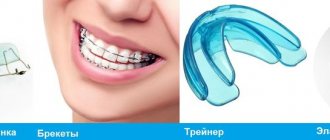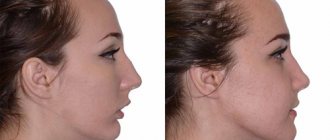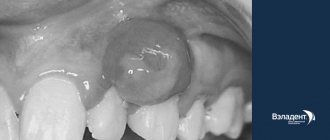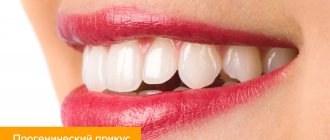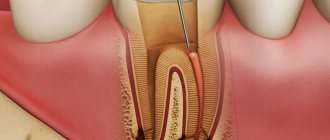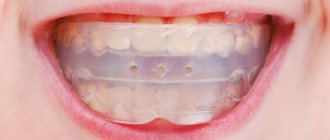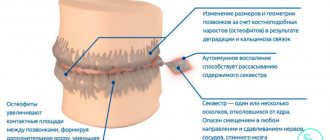Orthodontic dental treatment involves a range of dental services to correct the bite and eliminate related problems. In modern dentistry, this means not only installing braces and making trainers, but also, if necessary, surgical intervention.
One type or another of malocclusion can be diagnosed in most of the world's population. But for some people it causes especially many problems, from a feeling of psychological discomfort caused by uneven teeth, to health problems, for example, frequent diseases of the teeth and gums.
The goal of orthodontic treatment is to correct dental malocclusion.
Whatever method of teeth straightening you choose, you should remember that orthodontic treatment is always a very time-consuming process. Therefore, you need to start it with patience and prepare to wear an orthodontic appliance for a long time.
Methods for correcting bite
Today, dentistry uses two main methods: hardware and surgical. They are radically different and are prescribed for different indications. In addition, orthodontic treatment sometimes uses one combined method, as well as special functional therapy.
Hardware method
The hardware method, in simple terms, is a correction of the bite using removable or non-removable orthodontic structures of braces and plates. Many people have heard about this treatment. It is based on a mechanical effect on individual teeth or areas of the dental system, rebuilding bone tissue. Under mechanical pressure:
- individual teeth move;
- some malocclusions are corrected;
- the ratio of the dentition is normalized.
The orthodontist regulates the force of impact by changing the tension of rubber rods, wire arches, springs and special screws.
Surgical method
In case of pronounced deformation of the dental arches or disproportion of the jaws, the only possible option for correcting the situation will be a surgical method of treatment, an operation to change the shape of the jaw bones. Also, during surgery, you can turn the tooth around.
Hardware-surgical method
In some cases, the device is installed only after surgical preparation. As a rule, this is the removal of excess teeth to provide additional space in the dentition or trimming the frenulum of the tongue.
Functional method
This technique cannot be called completely orthodontic treatment, since it includes special gymnastics for the masticatory and facial muscles, general health measures, and strengthening the body’s natural strengths. Systematic exercises normalize muscle function, ensuring the harmonious development of the skeletal system.
In childhood, these measures have a good effect, allowing you to prevent abnormal development of the bite or completely get rid of it with the help of hardware treatment without relapses in the future.
Additional consultations
Osteopath
To assess the rationality of further treatment, it is necessary to understand the cause of the malocclusion. Within half an hour, the osteopath assesses the condition of the body and asks you for the necessary information. There are two possible reasons for changes in air flow:
- Malocclusion is a consequence of osteopathic problems. For example, violations of posture, the structure of the pelvis, the functioning of internal organs and other features of the body have a direct impact on the structure of the jaw, skull and bite formation. In this case, first of all it is necessary to undergo treatment from an osteopathic doctor. Otherwise, correction of the bite will not remove the root cause and may be ineffective or lead to failure of adaptation, that is, to discomfort and pain in those areas of the body that have been adapted to the incorrect bite.
- Malocclusions and pathological patterns in the structure of the skull cause changes in posture and body condition. In this situation, the osteopath will prepare the body for the changes that follow the correction of the bite.
A timely consultation with an osteopath from the “Orthodontist Project” makes it easier for the body to adapt to changes and reduce treatment time. This approach has proven to be effective. You can be sure that the body is prepared for bite correction and that the result will be stable.
With changes in the position of the head and the work of the jaw, the muscles begin to work differently and overstrain may occur. The osteopath monitors any changes in posture at all stages of treatment and alleviates muscle tension.
Speech therapist and myofunctional therapist.
Do not underestimate the pressure that the tongue exerts from within. If the muscles of the tongue do not work correctly, the tongue may push out the teeth, and it will not be possible to maintain the correct position of the dentition after correction. A striking example of treatment failure for such problems is repeated treatment after bite correction. Without myofunctional correction, the muscles of the mouth and the entire maxillofacial area continue to work in their usual position and the teeth return to their old places. Therefore, it is necessary to evaluate the work of the intraoral muscles, their tone and performance during function. It is also necessary to find out the presence of bad habits that affect the teeth (the habit of gnawing something, biting the cheek, etc.) and eliminate them.
ENT
Problems in the field of otolaryngology can affect the bite. For example, if the nasal septum is bent and breathing is difficult, the mouth is constantly open. This affects the formation of the bite. Enlarged adenoids, seals in the maxillary sinuses, allergies and other aspects that need to be identified before the correction can be affected in a similar way. In our clinic you can get an hour-long consultation with an ENT specialist, identify difficulties and receive the necessary treatment. The orthodontist always refers for ENT diagnostics if a problem with breathing through the nose is detected.
Neuromuscular dentist
This specialist conducts an examination using a special technique and determines what position the lower jaw should take by the end of the correction process. Diagnostics by a neuromuscular dentist allows you to see the correct position of the lower jaw according to the structure of the skull and the balanced work of all muscles of the maxillofacial area and the entire posture. Also, during the consultation, problems in the temporomandibular joints may be identified. This is also worth considering when planning orthodontic treatment.
Neurologist
A consultation with a neurologist is not prescribed in all cases. But if the patient complains of a headache, it is simply necessary. It is necessary to determine the cause of pain in the head, neck or facial muscles. The work and symmetry of the facial muscles is also assessed. During the hour-long consultation, the need for additional treatment may be identified.
Therapist-dentist
At the time of installation of corrective structures, teeth and gums must be healthy. Therefore, consultation with a dentist is necessary. He will look to see if there is caries on the teeth, if there are any defects or other diseases that require treatment. 30 minutes are allocated for this consultation.
Orthopedic dentist
Before installing braces or aligners, you need to make sure that the anatomy of the teeth is correct and that no additional difficulties will arise due to the disturbed shape of the teeth, chips or cracks.
Perfecting your smile is a long-term project and requires foresight. You may want to have your teeth whitened or have your teeth restored with crowns or veneers. If some teeth are missing, you can consider prosthetics and implantation. If you plan to carry out such treatment after straightening the dentition, it is necessary to project and prepare the necessary space. An orthopedic dentist will take care of the aesthetics of your smile and discuss the correct placement of teeth with the orthodontist before the correction begins.
Periodontist surgeon
If the gums are receding and the necks of the teeth are exposed, a consultation with a surgeon is necessary. It is necessary to determine the volume of soft tissue, since when teeth move while wearing braces or aligners, gum recession may worsen. You may also need to undergo plastic surgery of the frenulum of the tongue or lips.
Cosmetologist
At the “Orthodont Project” clinic you can take the opportunity to consult a cosmetologist. We believe that such a consultation gives patients even more confidence in the aesthetic results after treatment. The cosmetologist will help eliminate the last consequences of malocclusion, such as wrinkles and deep folds, and bring your smile to perfection. As a rule, a consultation with a cosmetologist lasts 30 minutes.
Stages of orthodontic treatment
- Diagnosis of malocclusions;
- X-ray examination of the jaw bones;
- selection of dental treatment methods and necessary orthodontic equipment;
- sanitation of the oral cavity, treatment of diseased teeth and gums, professional cleaning, etc.;
- installation of orthodontic apparatus;
- regular observation by a doctor, adjustment of the device;
- retention period to consolidate the achieved result;
- removal of orthodontic equipment.
Orthodontics – Prices
| Services | Price |
| Manufacturing of diagnostic models | 1200 rub. |
| Consultation with an orthodontist | 1100 rub. |
| Repeated consultation with an orthodontist | 500 rub. |
| Taking an impression | 950 rub. |
| Determination of central occlusion on a wax template, constructive. Bite | 1200 rub. |
| Planning the scope of treatment, drawing up a treatment plan | 2000 rub. |
| Calculation of diagnostic models (one jaw) | 500 rub. |
| Training in the rules of oral hygiene during orthodontic treatment (removable appliances) | 500 rub. |
| Observation during treatment with removable equipment | 1100 rub. |
Types of orthodontic structures
A lot of orthodontic devices have been developed, but they all belong to one of two large groups:
- removable;
- non-removable.
Removable structures
This group includes:
- mouth guards;
- vestibular plates;
- trainers.
Such structures are most often used in pediatric orthodontics to correct the bite of baby teeth.
Among adult patients, special mouthguards for correcting bites are very popular. But these designs are effective only for minor bite defects. Treatment with their help is expensive, time-consuming and useless for serious malocclusions. The choice of teeth straightening technology should be entrusted to a specialist. To do this, you need to sign up for a consultation at a serious dental clinic and certainly not engage in self-diagnosis and self-medication.
Fixed structures
They are mainly represented by fairly well-known bracket systems, of which there are several types, differing in materials and design. Materials used for the production of braces:
- metal;
- ceramics;
- plastic;
- sapphires;
- gold.
Some models of braces are located on the outer side of the dentition, they are called vestibular, others on the inner side, on the side of the tongue, lingual.
Reduced chewing efficiency due to lack of a chewing band
Before
Stages
After
Specialists:
Denisova Ekaterina Alexandrovna
The main complaint in this clinical case was reduced chewing efficiency due to the absence of almost the entire chewing group of teeth in the lower jaw.
During the preparatory stage before orthodontic treatment, bridge structures on the upper jaw were removed. The abutment teeth are covered with single composite crowns fixed using an adhesive protocol. The goal of orthodontic treatment was to prepare the dental system for subsequent rational prosthetics, guaranteeing long-term stability of the result. Implantation of missing teeth was carried out at the stage of orthodontic treatment, just like temporary prosthetics. After the braces were removed, all temporary structures were replaced with permanent ones.
Choice of orthodontic treatment
Since there are so many orthodontic treatment options, there are many to choose from. However, this is not easy to do; you need to take into account a lot of indications and contraindications. A specialist should deal with this issue; the patient has the opportunity to express his preferences. But the final word should remain with the doctor.
- When correcting a child’s bite, removable structures are a very good option. A child's jaw is very pliable; it reacts even to minor mechanical influences of a short duration. Therefore, convenient removable structures can cope with malocclusion development;
- removable orthodontic aligners are an option for correcting minor bite defects. But the defect must be really insignificant, otherwise the mouth guards will be a waste of money. The decision should be left to the dentist;
- To correct a more or less formed bite, braces are the best option. Here the patient has a wide scope; he can choose the materials and type of construction himself. But some restrictions are still present. Despite their high aesthetics, lingual braces are not able to eliminate all dental defects. Sapphire and ceramic systems are fragile and therefore are not very effective against serious anomalies. The opinion of the attending physician when choosing a brace system should remain decisive;
- When correcting serious malocclusions, there are few treatment options. Most often this is a surgical intervention, supplemented by the subsequent wearing of braces;
- For children, functional methods are recommended to prevent malocclusions, as well as correct minor defects.
Orthodontist appointment
The orthodontist’s task is to identify the main problems of bite and abnormalities in the structure of the jaw within an hour. After this, the doctor finds out the patient’s expectations and wishes, suggests possible treatment, and determines the approximate time and cost. Also, the orthodontist can talk about the experience of correcting the bite in similar situations and show the final result. And, of course, our specialists are sure to answer all questions that patients have.
An important part of dental treatment is maintaining a personal medical record. The following data is entered into it:
- The problem the patient addressed and the desired result
- History of the formation of malocclusion. This includes the time when teeth began to change, their characteristics and recent changes in their condition.
- Results of the initial examination
- Presumable diagnosis
- Results of additional examinations, consultations and diagnostics.
At this stage, if the patient agrees to further treatment, an action plan is drawn up. Although after the first consultation we can draw a conclusion about which equipment and which treatment method is best suited, we in no case neglect diagnostics. The use of scans and x-rays increases the accuracy of the forecast for the final result. Consultations with an osteopath, ENT specialist, neurologist and other specialists allow you to get the most complete picture of what is happening with the bite, jaws and skull, sensibly assess all the possible pros and cons and choose a treatment plan.
Over the years of practice, we have been convinced more than once that no two cases are identical, so this approach helps to remember the uniqueness of the patient and create an individual project for occlusion correction.
From the experts
In addition to all the above recommendations, experienced orthodontists offer a number of tips based on practical observations:
- For adults, before installing braces, it is better to remove their wisdom teeth, even if they have not yet erupted, since there is a high risk of them being damaged by caries;
- When choosing a doctor, make sure that the examination is thorough. If the orthodontist suggests putting on braces right away, this is a bad sign. However, another recommendation indicates the low qualifications of the specialist - he suggests waiting to start treatment. Most likely, he does not understand how to solve your problem;
- it is very important to treat all teeth before correcting the bite; in addition, you must learn how to clean them correctly so that while wearing braces the enamel does not become caries;
- Soft tissue adjustments may be required before treatment. You should not be afraid of this; if the doctor suggested performing the procedure, then it is really necessary.
Skeptics believe that correcting a bite in adulthood is useless, and braces are only effective on children’s teeth. This is not a completely correct opinion, but in some ways they are right:
- more significant pressure has to be exerted on the teeth of an adult, which leads to painful sensations at the initial stage;
- some teeth have to be removed to make room for others;
- Bridges and crowns have to be removed during treatment, which also does not add pleasant moments to the procedure.
INVISALIGN mouth guards
Paris
Michel Cassagne: specialist from France.
Orthodontist
Our orthodontist, Dr. Michel Cassagne, was one of the first orthodontists to use Invisalign. He has the most experience with them and appreciates their effectiveness and practicality.
Aligners and trays for moving teeth are the most advanced technology in orthodontics.
- Mouth guards are an innovative technology in orthodontics
- Completely invisible to others
- Absolutely comfortable to wear
- Easy to care for and maintain hygiene
- No restrictions on food
Minor “troubles” after the procedure
After the doctor installs a removable device and adjusts it, the patient’s diction is impaired. Don't worry about this - it's completely normal. This occurs due to a decrease in the total volume of the oral cavity. After some time, the language will get used to it. It often takes him a couple of days to do this. To restore your diction, you can read a book out loud.
After the first installation of the device, low pressure is applied to the teeth. It goes away in just a few minutes. But if this does not happen and the patient complains of unpleasant sensations (cutting, pricking), the device must be removed. Only after this you need to get to the dentist as quickly as possible, who will correct the situation. If you delay the procedure, the relief of the mucous membrane will change, making it impossible to put the device back on. This will require ordering a new one and repeating the procedure.
The device must be looked after. It requires cleaning with a special paste at least twice a day. And this must be done with a separate brush. If you ignore this requirement, an unpleasant odor will soon come from your mouth. It is also important to store the device correctly. When dry, it must be placed in a special box. The dentist will give it to you.
